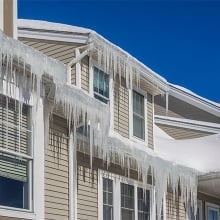How to Unclog a Downspout
Gutters play a crucial role in protecting your home from water damage. They collect rainwater and direct it away from your roof, walls, and foundation. However, over time, gutters can become clogged with leaves, debris, and dirt, which can hinder their functionality. One of the most common issues homeowners face is a clogged downspout, which can lead to water overflow and potential damage. In this guide, we’ll show you how to unclog your gutter downspout and discuss why it’s vital to keep your downspouts clear and divert water away from your home’s foundation.
Why Unclogging Downspouts Matters
Prevents Water Damage
Clogged downspouts can cause water to overflow from your gutters, leading to water damage to your roof, siding, and even the interior of your home. Water intrusion can result in costly repairs.
Protects Foundation
One of the most critical reasons to unclog downspouts is to prevent water from pooling around your home’s foundation. When water isn’t properly diverted away, it can weaken the foundation, potentially leading to cracks and structural issues.
Avoids Mold and Mildew
Excess moisture around your home due to clogged downspouts can create an ideal environment for mold and mildew growth, which can be harmful to your health and your home’s structural integrity.
How to Unclog a Gutter Downspout
Before you start, gather the following tools and materials:
– Safety gear (gloves and safety glasses)
– Ladder
– Garden hose with a nozzle attachment
– Bucket
– Plastic scoop or trowel
– Plumber’s snake or drain auger (optional)
– Downspout strainer (to prevent future clogs)
Follow these steps to unclog your gutter downspout:
Safety First
Always prioritize safety. Wear gloves and safety glasses to protect yourself from debris and potential splashing.
Set Up Your Ladder
Carefully position your ladder near the clogged downspout, ensuring it’s stable and on a level surface. Have someone hold the ladder in place if you feel uncomfortable working from it.
Remove Debris from the Top
Use a plastic scoop or trowel to remove leaves, twigs, and other debris from the top of the downspout. Be gentle to avoid damaging the gutter.
Use a Plumber’s Snake or Auger (Optional)
If the clog is stubborn, you can insert a plumber’s snake or drain auger into the downspout to break up the blockage. Push and twist the tool gently to dislodge the debris.
Flush with Water
Attach a garden hose with a nozzle attachment to a water source. Position the hose at the top of the downspout and turn on the water. The high-pressure stream should push the remaining debris down and out of the downspout. Be prepared for water and debris to flow out of the bottom.
Check for Proper Flow
After flushing the downspout, check if the water is flowing freely. If it’s still slow or blocked, repeat steps 3 to 5 until the downspout is clear. Also, use this time to ensure that the water is being directed away from the foundation of your home.
Install a Downspout Strainer
To prevent future clogs, consider installing a downspout strainer at the top of the downspout. This will help keep leaves and debris out of the downspout while allowing the water to flow through.
Importance of Diverting Water Away from the Foundation
Now that you know how to unclog a downspout drain, it’s equally crucial to understand the significance of diverting water away from your home’s foundation.
Foundation Protection
Properly functioning downspouts direct rainwater away from your foundation, preventing soil erosion and potential damage to the foundation itself. This is essential for maintaining your home’s structural integrity.
Prevents Basement Flooding
When water is allowed to pool around your foundation, it can seep into your basement or crawl space, leading to flooding and costly water damage.
Landscaping Preservation
Effective water diversion helps protect your landscaping by preventing soil erosion and root damage.
Need Help? Call The Pros
Maintaining your gutter downspouts and ensuring they are free from clogs is essential for safeguarding your home from water damage and foundation issues. By following the steps outlined in this guide, you can effectively unclog a gutter downspout and prevent future problems. Most homeowners can get the job done with a little bit of DIY skill.
If you’re in Indiana and need professional assistance with your gutter system, consider contacting Kingdom Roofing Systems. As a full-service residential and commercial roofing contractor, we have the expertise to handle gutter-related issues and can help ensure your home remains protected from water damage.
Don’t wait until the next heavy rainfall to address your gutter and downspout maintenance needs. Protect your home by ensuring those downspouts are clear today!




